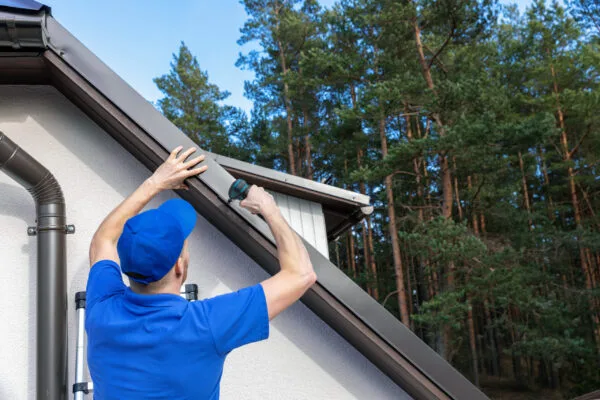Roofing is a critical aspect in the construction industry and plays a vital role in the safety and durability of any building. From shingles to underlayment materials, every component is essential to reinforce the roof’s structure and protect it from harsh weather conditions. One critical component of any roofing system is the drip edge.
A drip edge is not only important for the roof’s protection but also for the homeowner’s safety. Without a professionally installed drip edge, water can seep into the roof deck, causing moisture buildup and eventually leading to rot and mold growth. This can be especially dangerous if the water comes into contact with electrical wiring or components within the walls. Additionally, a professionally installed drip edge can improve the overall aesthetics of the roof by providing a clean, finished look.
What Does a Drip Edge Do?
A drip edge is a metal strip of flashing that is commonly used in roofing systems. It is installed along the edges of a roof, typically underneath the shingles or other roofing materials. The main purpose of a drip edge is to provide protection against water damage. It has several essential functions including:
Firstly, the angled design of the drip edge helps to divert water away from the underlying structure of the roof, such as the fascia, soffit, and the eaves. By directing water away, it prevents water from seeping into the roof deck, which could lead to rot, mold, or other forms of water damage.
Secondly, the drip edge helps prevent soil erosion around the foundation of the building by channeling water away from the roof edges. This is particularly important in areas with heavy rainfall or where water runoff may cause damage.
Thirdly, the drip edge acts as a protective barrier for the vulnerable edges of the roof. It shields the exposed wooden components, such as the roof deck and the fascia, from water infiltration and potential damage. Lastly, the drip edge contributes to the aesthetics of the roof by providing a neat and finished appearance to the roofline, as it covers the edges of the roofing materials.
What Does a Drip Edge Look Like?
A drip edge on a roof typically appears as a narrow metal strip that runs along the edges of the roofline. It is usually positioned just beneath the outermost layer of roofing material, such as shingles. The drip edge is characterized by its L-shaped profile, with one side extending over the edge of the roof and the other side angling downward. The downward angle helps to direct water away from the roof and prevent it from seeping into the underlying structure.
The top portion of the drip edge often features a flange or lip that helps to further channel water away from the roof’s edge. Depending on the specific design and materials used, a drip edge can come in different colors, typically matching the roof or trim. Overall, it provides a clean and finished look to the roofline while serving the important function of protecting the roof and underlying components from water damage.
Material Types for a Roof Drip Edge
Drip edges are typically made from various materials, each offering distinctive characteristics and benefits. Here are some common types of drip edge materials:
Aluminum
Aluminum drip edges are widely used due to their lightweight nature, durability, and resistance to corrosion. They are easy to work with and offer excellent protection against water damage. Aluminum drip edges are often available in different colors to match the roofing material or desired aesthetic.
Galvanized Steel
Drip edges made of galvanized steel are known for their strength and longevity. The galvanization process involves coating the steel with a layer of zinc, providing enhanced corrosion resistance. Galvanized steel drip edges are sturdy and can withstand harsh weather conditions, making them a popular choice.
Stainless Steel
Stainless steel drip edges offer exceptional durability and resistance to corrosion. They are particularly suitable for areas with extreme weather conditions or near coastal regions where saltwater exposure is a concern. Stainless steel drip edges provide long-lasting protection and require minimal maintenance.
Vinyl
Vinyl drip edges are lightweight, affordable, and easy to install. They are resistant to rust and corrosion, making them a suitable choice for areas with moderate weather conditions. Vinyl drip edges are available in distinct colors, allowing for customization and coordination with the roof’s appearance. Vinyl may not be as durable as its metal counterparts.
Copper
Copper drip edges are known for their aesthetic appeal and natural resistance to corrosion. They develop an attractive patina over time, adding a distinct look to the roofline. Copper is a premium material that offers excellent durability, but it tends to be more expensive than other options.
It is important to consult with roofing professionals or refer to local building codes to determine the appropriate drip edge material for your specific region and roofing requirements.
Drip Edge Styles
Drip edges on roofs come in a range of styles, characterized by their shape and installation method.
The most common style is the L-shaped drip edge, featuring one side that extends over the roof’s edge and another side angling downward. This design directs water away from the roof’s edge and into the gutters or away from the building.
Another style is the T-shaped drip edge, which resembles the letter “T” and offers extended coverage and protection by reaching further onto the roof deck. For flat or low-slope roofs with gravel as a roofing material, there is the gravel stop drip edge, which acts as a barrier to prevent gravel from sliding off the roof edges and diverts water away.
Eave drip edges are specifically installed along the lower edges of the roof, protecting the fascia and soffit from water damage while providing a polished appearance to the roofline.
Similarly, rake drip edges are installed along the gable ends of a roof, serving the same protective functions and giving a clean finish to the gable area.
Are There any Outstanding Issues With Your Roof?
When it comes to roofing, drip edges are a crucial component that homeowners should not overlook. They serve as a protective barrier that directs water away from the roof’s edges, preventing damage to the roof deck, fascia, and soffit. Not only that, but appropriate drip edge installation can also contribute to the overall aesthetics and longevity of the roofing system. Choosing the right drip edge material and style for your specific needs and location is key to ensuring the continued protection and maintenance of your roof.
That is where DaBella steps in. DaBella is highly regarded in the roofing industry and is considered a GAF Master Elite roofing contractor. We are proud to offer a wide selection of high-quality roofing replacement options that are made to last. Durability is not the only factor to consider when choosing a roofing material, however at DaBella, we prioritize both functionality and aesthetic appeal. Our team of experts can help guide you in selecting the appropriate roofing material and drip edge style for your unique needs and preferences. With our top-notch materials and expert installation services, your roof will not only protect your home but also enhance its curb appeal.
Contact DaBella today to schedule your free no-obligation estimate. Our team of experts is dedicated to providing top-notch roofing services, including new installations, repairs, and replacements. With our years of experience and commitment to quality craftsmanship, you can trust that your roof is in good hands. Do not wait until it is too late – contact DaBella now at 844-DaBella to ensure your roof is prepared to withstand any weather conditions.

